
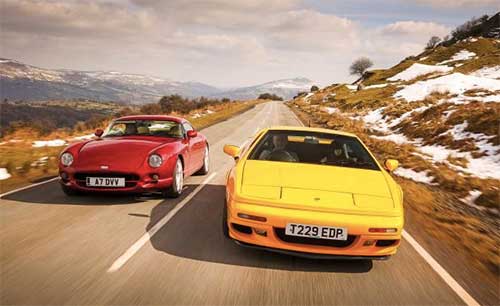
Brave new world
TVR Cerbera vs Lotus Esprit
By Ross Alkureishi
Blighty has always loved an automotive underdog, be it in motorsport competitions such as Le Mans where the mechanical bitsa Healey 100S put the frighteners up more thoroughbred machinery by finishing first in class and 12th overall in 1953, or in the manufacturing field where low-volume British sports car producers rose to excel in the aftermath of WW2.
From humble beginnings, two in particular became renowned among enthusiasts for the delicacies of their sporting output: Lotus for its cars' lightness of touch and handling prowess, and TVR for its out-and-out road-burners.
In both cases their formulae for success proved remarkably similar, with glassfibre being the go-to body material, usually allied to a lightweight chassis with borrowed mechanicals.
If we're being honest they produced good, occasionally scintillating road cars, enjoyable to drive but usually bringing the associated challenges – build quality, reliability – that come with small-scale production; nothing to worry the Ferraris and Porsches of this world.
Both have double-wishbone front suspension, but the TVR is 615lbs lighter
Come the '90s, though, and both began to develop ideas above their station.
Over at Hethel plans were finally – some 20 years after release – being concocted for the integration of a V8 into its flagship model.
Meanwhile, up in Blackpool, a new wave of serious high-performance machines was about to take the fight to the Continental old guard.
Over the intervening decades, Lotus did an incredible job keeping the Esprit credible. From its initial Giugiaro-penned, tartan-trimmed arrival, to the introduction of turbocharged power in 1980 and Peter Stevens' svelte modernising restyle in 1987, the model designations fairly flew by.
In 1996, at a time when it could have been put out to pasture, the faithful were instead able to rejoice in the arrival of the Lotus-designed 3.5-litre twin-turbocharged V8. Here at last was the engine to silence the haters.
TVR's assault on the world of modern highperformance took a different path.
Its second decade under Peter Wheeler's stewardship consigned the wedge to history as three boldly sculpted beasts arrived: first the Griffith, then Chimaera and, in 1996, the Cerbera.
Delays to the development of the in-house AJP8 engine meant that existing drop-top models continued to be powered by the venerable TVR-developed Rover V8. But it was ready to be unleashed for the 2+2 coupé Cerbera.
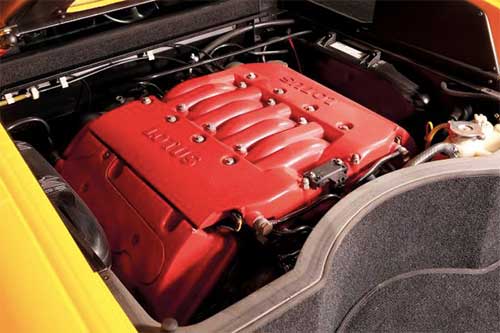
The Lotus' 3.5-litre V8 has 350bhp and 295lb ft of torque
It takes a certain something to upstage a TVR of this vintage but, parked up side-by-side, the Esprit V8 GT just about manages that.
Despite my instinct to reach for the Norfolk Mustard descriptor, this one has the New Lotus Yellow (Spice) paintjob – surely its best colour.
The Stevens update, tweaked further by Julian Thomson for the 1993 S4, does an incredible job of masking the base wedge – albeit one that's always scored high on visual drama, but that's also a contemporary of the supremely pointy Ferrari 308GT4 and the like.
They say 'you can't square the circle' but Stevens certainly managed to somewhat circle the wedge.
Meaty wheelarch extensions, Magnesio OZ Racing alloys bound in fat rubber, delicately scalloped sills and a wild rear spoiler – actually deleted on the GT, but reinstated here by the original buyer – complete the visuals.
Sitting amidships in this glassfibre exotic is the star of the show: the Type 918 double-overheadcam, flat-plane-crank V8.
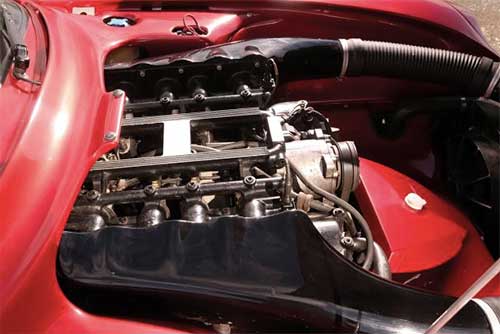
The TVR responds with 360bhp and 320lb ft of torque from its 4185cc V8
It should be more than enough to cow its rival, but since when has any TVR entertained the thought of shrinking any violets?
The very fact it's named after Cerberus, the mythological hell dog, should be enough of an indicator, yet its Damian McTaggart-penned aesthetics are long, sleek, calming and an antidote to the sharp-angled multitude of the previous Blackpool generation.
But with that low roofline the TVR retains a distinct but subtle sense of hoodlum – if the Ant Hill Mob had reappeared in the '90s, you get the feeling they'd be driving a Cerbera.
Its return to the sinuous design cues – like those of Griffith and Chimaera – of the '50s and '60s sports cars have an instant ageing effect on its Hethel rival even if, visually at least, the V8 GT looks as if it should devour it whole.
Just like the Lotus, the Cerbera features an in-house-developed flat-plane V8, the 4.2-litre AJP8 (or Speed 8) – later bored out to 4.5 litres. With a power output of 360bhp and 320lb ft of torque, it takes Top Trump bragging rights.
The door opens on the press of a button under the door mirror to reveal another first: a wild, trippy and thoroughly homegrown interior environment – one designed possibly after a late night viewing of '60s classic Barbarella and one too many prescription painkillers.
It's well constructed – although in hard-driven, high-mileage cars it can age badly – with not a plastic rim, switch or knob in sight; instead, bespoke brushed alloy is the name of the game.
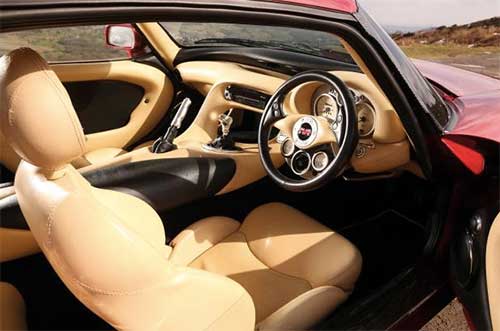
Press a button under the door mirror to reveal the Cerbera's cabin
Turn around and rather than the anticipated comedy '+2' rear seats, you find there's actually room for a couple of tykes in the back.
Firing on the press of a button located on an auxiliary dashboard, behind the lower portion of the steering wheel, the engine is bellicose in the extreme as it clears its throat through twin-exit exhaust pipes. There's no lazy US 'lubba-lubba' burble here, this is a race-derived unit from the one-make Tuscan Challenge and its 75º banks hit a strident note from the off.
The controls are surprisingly easy to manhandle, with just the long-travel throttle feeling a smidge heavy – no surprise, given the total absence of driver aids and sheer ferocity on tap.
Curiously, I've driven around eight of the 'softer' Speed Six Cerbs, but never a V8; both, as we're finding out, are seriously brutal in their delivery, but while the six-cylinder unit never deviates from a full-on baritone battle cry, this engine builds to a hard-edged race howl at around 6000rpm. It's delicious.
The only problem up here in the stunning mountainsides of the Brecon Beacons is running out of straight road. Surely there's somewhere we can spin it up towards its 180mph top speed?
Perhaps not, although experiencing its 4 secs 0-60mph sprint time is do-able – both stats propelled the Cerbera towards the very top of the performance tree when new.
Although it's in essence a GT, there's still plenty of fun to be had on twisty B-roads; it's not as nimble as a Griffith or Chimaera but there's plenty of grip available.
Harnessing the huge four-pot AP Racing anchors to scrub off speed as we approach a tight sweeper, we swiftly turn-in but lay down the power a smidge too early on exit; an aggressive wiggle of its tail is the helldog's warning to modulate your right-foot pressure.
Back up on top of the world and another short straight beckons, so it's pedal to the floor – because you must – and a welcome return to a world of aural glory.
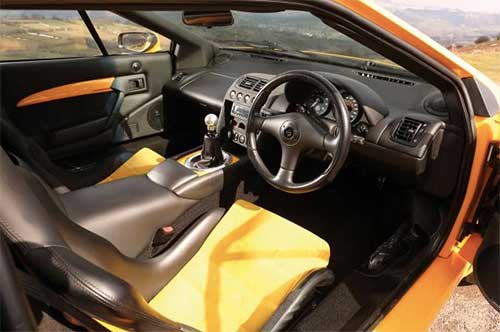
The Esprit GT boasts fixed-back composite racing seats
The Esprit GT arrived in '98, two years after the original V8, as a basic entry-point sports version; gone were air conditioning and soft leather trim, and in came the GT3's fixed-back composite racing seats and Alcantara.
A cheaper, basic-spec car when new, the model is liked now and you can see why; the cabin is a purposeful, colour-matched riot – like entering the Kiss dressing room for an after-concert party – and a notch up on earlier walnut-dash iterations.
Once ensconced, though, its parts-bin feel is a mite disappointing compared to the Cerbera's handmade environment.
The controls feel manly, though, with a thick Momo sports steering wheel and bull-necked alloy gearlever – the TVR's are somewhat effete in comparison.
That said, the Lotus V8 fires with none of the drama of its rival, settling into an even, flat-toned tickover. Engage the twin-plate AP Racing clutch – my, that's heavy. Slot the gearlever into first – an equally weighty manoeuvre. Then it's down with the throttle – ditto.
Out on the road, the two give perhaps surprisingly different driving experiences
Given the above, the surprise is that the steering feels instantly nervous and light, even in a straight line; unlike in the sure-footed TVR, you're instantly on guard. After a few miles, you realise it's just the über-direct nature of the steering rack that causes the front tyres to twitch on even the smallest imperfection, and you're able to relax and begin exploring the performance.
Drop it into second, floor the pedal and before you know it you're in top gear and engaging the Esprit's equally competent AP Racing brakes, here endowed with ABS.
Time for a second blast to try to process the machinations of its power delivery; it's bam-bam-bam-bam through the gears as, unlike the progressive torque delivery of the naturally aspirated Cerbera, the twin turbochargers dump the V8's power in short, staccato bursts of neck-snapping ferocity.
It's definitely a less relaxed driving experience – strange, thinking of a car with the Cerbera's capabilities being a more tranquil place to be – and by blinding the senses feels faster because of it, despite an 0.8 sec disparity in its 0-60 ability.
Unlike in the TVR, your first encounter with a corner is a thing of majesty. At just 50kg heavier than its four-pot predecessor, the integration of the larger engine hasn't blunted the Esprit's underlying handling prowess.
Gone is that straight-line nervousness as you play the game of seeing how early you can apply the power, and zip nimbly through to devour the next.
It remains flat and neutral, and long after the Cerbera would have been sniffing its own tail the GT's distinctive flat bark exhaust note would be way off in the distance up ahead.
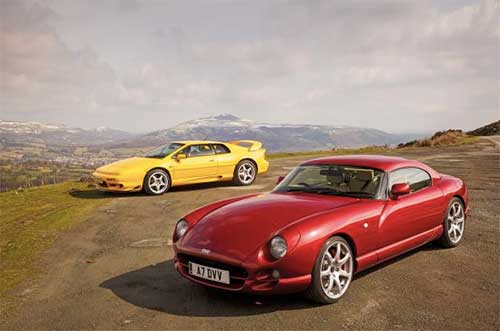
The Cerbera shows the Esprit a clean pair of heels on a straight, but the Lotus is the more rewarding car in the bends, thanks in part to better body control
Today, prices for the best Lotus Esprit V8 GTs and TVR Cerberas have moved north of £40k, but very good drivers with 40k-60k miles on the clock can still be had for much less.
The key to both is buying well. "Body and interior condition are easy to visually check," says Paul Jackson of Bristol-based TVR specialist Amoré Autos.
"Beware of a badly worn interior, which can cost thousands of pounds to replace. Provenance and service history are key – especially important if maintenance has been skimped on; have the correct 6000/12,000 services been done, and is one due?
"Chassis outriggers and main rails are prone to corrosion, so should be inspected, and look for any oil leaks underneath because a front cover seal leak can mean taking the engine out. Most important, view a few – each one will feel different – and pay the right price for the condition of the car; asking prices vary hugely."
Scott Walker is Lotus UK's sales manager and model expert: "V8s have a reputation for costs associated with mileage and are expensive to put right when things go wrong, so buy and inspect on condition all over and mileage.
"Corrosion is a real menace – the V8 did without the flat undertray of the four-pot cars because of heat. Everything rusts on cars in bad climates. Carefully check fuel tanks – located in the body recess ahead of the rear wheels – and all ancillaries.
"Cambelts need to be changed at 24k miles. Also, ensure the cooling system works correctly, because removing components without damaging oil coolers is time-consuming and expensive. Finally, check that the ABS works, the gearbox synchros are good and the clutch doesn't slip.
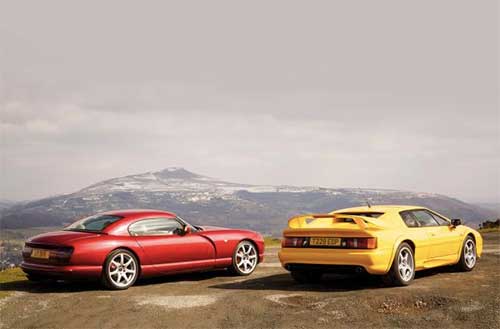
The twin-turbo V8 of the Esprit is neatly finished, but can be fragile – the TVR's rough-and-ready AJP V8 delivers monstrous grunt
Neither is a particularly cheap car to own and run. Jackson has owned a later 420bhp 4.5 Cerbera (a 440bhp 'Red Rose' power upgrade was also offered) and suggests budgeting £1500-2000 annually to average out bigger expenditure: "AJP8s are fairly bulletproof, but a Speed Six without an engine rebuild is a liability."
Esprit owner Tony Bagnall has had his V8 for three years now, and the only costs have been for scheduled maintenance. However it was a low-mileage, very well-maintained example. In truth, allowing for a similar running budget should cover most eventualities.
Today, both cars are pertinent reminders of when these low-volume manufacturers began to get seriously serious.
The Lotus still remains a flawed genius, unsuited to the rigours of daily driving – too tiring – but fleet of foot, majestic to behold and cracking for a special occasion blast.
For me, however, it's the Cerbera that takes the honours; with room in the back for two, a glorious interior and performance still wicked enough to scare the bejesus out of the supercar stalwarts, it teaches us what Americans have always known: with a V8 you get more bang for your buck – or quid, in this case.
Ross Alkureishi is a regular contributor to Classic & Sports Car
|
|